A couple of months ago, NZTA reversed its plans to install a median wire barrier on SH16 for stage 1 of the SH16 Brigham Creek to Waimauku project.
The project, which officially aims “to improve safety”, was – and still is – midway through construction, and the decision to delete the median barriers from the design appeared to have no real justification.
In fact, according to documents and correspondence obtained under the OIA and sent to us by a few people (huge thanks to them), this decision was made:
- Against all internal recommendations and advice
- Against consultation results and community support
- Counter to what NZTA itself argued when appealing in the Environment Court to progress the project
- and despite the reversal requiring the breaking of contractual agreements with Fulton Hogan
For context, this was the plan for Stage 1 (with Section E originally planned to have median barriers):
So why the sudden safety downgrade on a project in flight?
In a situation comparable to Project K, it appears that senior leadership in NZTA directed the project team to remove the barriers from the plan. They did so despite all internal advice saying do not do this, and despite the project being funded, contracted, and already under construction.
According to some of the internal emails obtained via the OIA, this reversal appeared to be spurred, at least in part, by a request from the Minister’s Office late 2024 when Simeon Brown was still the minister, in the context of his extremely ideological 2024 GPS.
Given the project was already funded, contracted and under construction, the 2024 GPS requirements to downgrade road safety shouldn’t have applied. So why did NZTA senior leadership choose to de-scope safety on this project, against their own expert advice?
First, let’s get into that advice.
NZTA’s Chief Engineer’s Advisory Group says ‘don’t do this’
In January 2025, the Transport Services GLT (Group Leadership Team) asked the Chief Engineer’s Advisory Group (CEAG) for the project to examine the need for the median barriers.
Outlined in a value assessment, this was what the CEAG determined:
Stage 1 is contracted and over 60% constructed. All messaging to date is that wire rope median barriers would be installed throughout the corridor. There are no significant cost savings to be gained by not installing the median wire rope barriers. The project has purchased several properties to construct turning facilities of which one owner has taken the project to environment court twice in opposition. If we were to remove the wire rope barrier from the scope of the project this would cause significant reputational damage for Waka Kotahi and stop the project meeting its investment objectives. The benefits of the wire rope barrier removal do not outweigh the disbenefits.
This paragraph on its own is a clear statement of why NZTA should not remove the median barriers from the plans. It sums up almost every aspect of the situation, and would be discussed later that January, in a CEAG meeting:
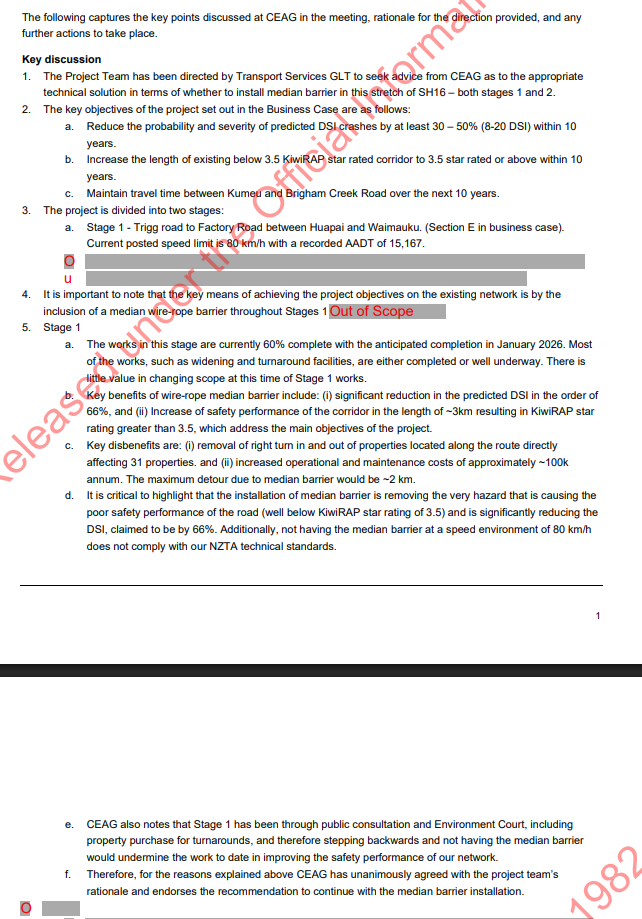 So, given the strong recommendation, justified on multiple grounds – why did the Transport Services Group Leadership decide to remove the median barrier?
So, given the strong recommendation, justified on multiple grounds – why did the Transport Services Group Leadership decide to remove the median barrier?
According to this email from a senior manager in Transport Services, they wanted to give more weight to community sentiment:
Last year in the Bay of Plenty, protests were occurring over safety barriers installed on SH2. So, was there perhaps a similar case of a community uproar in the Waimauku-Kumeu area?
Neither consultation results nor the community is calling to remove the median barriers
The sudden decision to remove the barrier was not consulted on, but community feedback had been sought on the original project. While sentiment was mixed, the safety goals of the project were well supported, with “no major outcry” against the median barriers; nor was there any “media attention” whatsoever.
Essentially, while some people were opposed to the project, many were also in support, and so there was no indication this was different than any other project.
Additionally, the Rodney Local Board was “generally supportive of the project including the median barriers.”
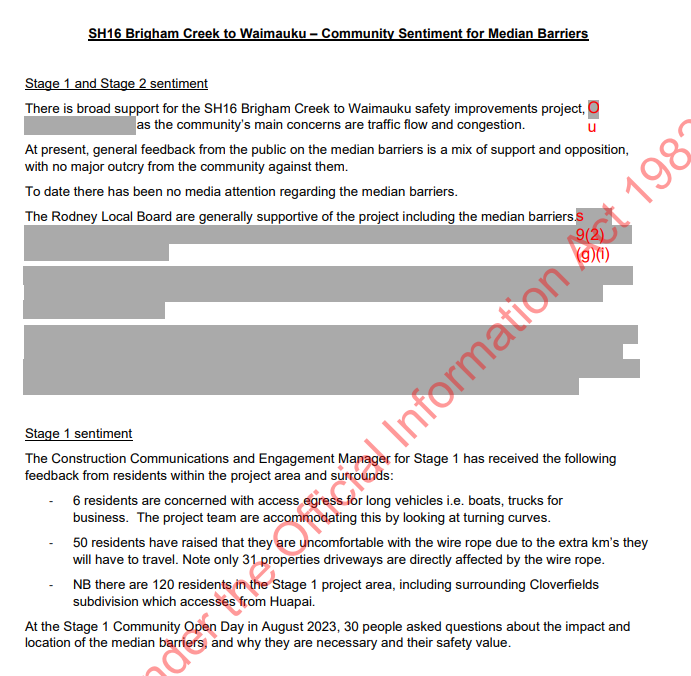 There’s also some interesting stuff regarding how the Rodney Local Board felt about the removal of the safety barriers. As per an April 2025 workshop, 6/8 board members were disappointed by the decision.
There’s also some interesting stuff regarding how the Rodney Local Board felt about the removal of the safety barriers. As per an April 2025 workshop, 6/8 board members were disappointed by the decision.
‘Questions answered using Key Messages’
The ‘key messages’ the NZTA team brought to the meeting with the Local Board spell out the official reasoning for the removal of the safety barriers (see page 3 onwards here).
One particular line of argument stands out amid the key messages: the concern of some residents about the extra distance they would need to travel due to the median barriers.
It stands out, because that concern had been explicitly addressed by NZTA when the project was initially consulted and designed. NZTA designed special turning bays – which are still in the design, i.e. they’re being constructed regardless. And not only did these turning bays require extra land take, one landowner took NZTA to court. Twice.
So it’s a complete farce that NZTA senior leadership would lean on this angle to explain why they’re suddenly removing the median barriers.
NZTA said in court that the barriers were necessary
Over 2021 and 2022, NZTA was taken to the Environment Court by a local landowner regarding the land take for the turning bays. In the court case, NZTA argued the need for the four turnarounds as a necessary mitigation to ensure access: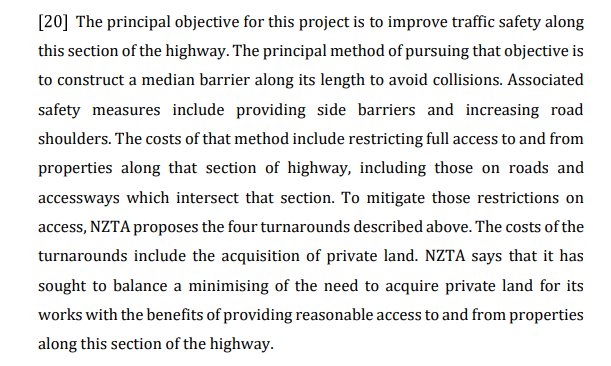 And, when it was raised that they could use other available options, i.e. other safety infrastructure, NZTA’s expert witness argued that only median barriers achieved the safety goals of the project:
And, when it was raised that they could use other available options, i.e. other safety infrastructure, NZTA’s expert witness argued that only median barriers achieved the safety goals of the project:
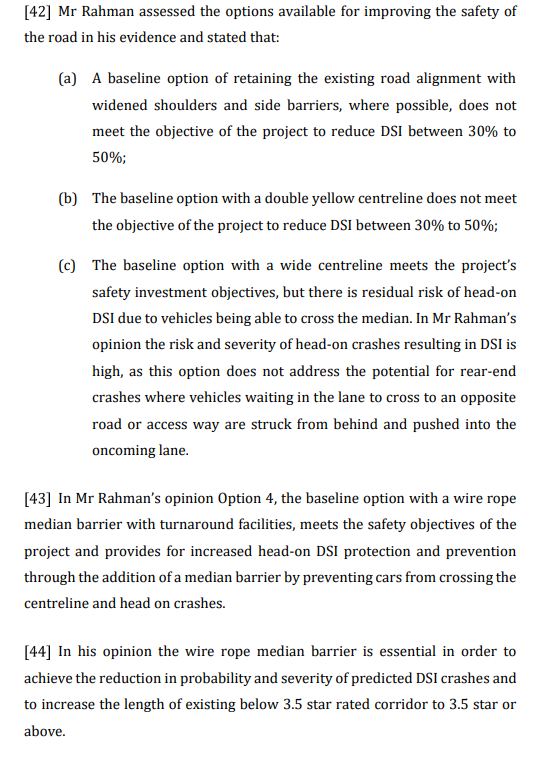 To be clear: NZTA fought a court battle, twice, and won, twice, both times on the basis of the median barriers being essential.
To be clear: NZTA fought a court battle, twice, and won, twice, both times on the basis of the median barriers being essential.
In order to ensure access for local residents it designed turnaround facilities, and acquired private land to do so, again defending the decision in court twice.
The turnaround facilities are now built, but the barrier will not. I would hazard a guess and say those turnaround facilities were a lot more expensive than the wire-rope median barrier.
And remember: this project was already under construction. So not only did this reversal by senior NZTA management have no justification, and not only did it contradict what the organisation had said, twice, in court, it also required adjusting a project mid-construction with already signed contracts.
Breaking promises and reputational damage
As outlined in this email from the Project Manager in December 2024, the physical works for Stage 1 were 55% complete at the same time as NZTA leadership was looking to remove the median barriers:
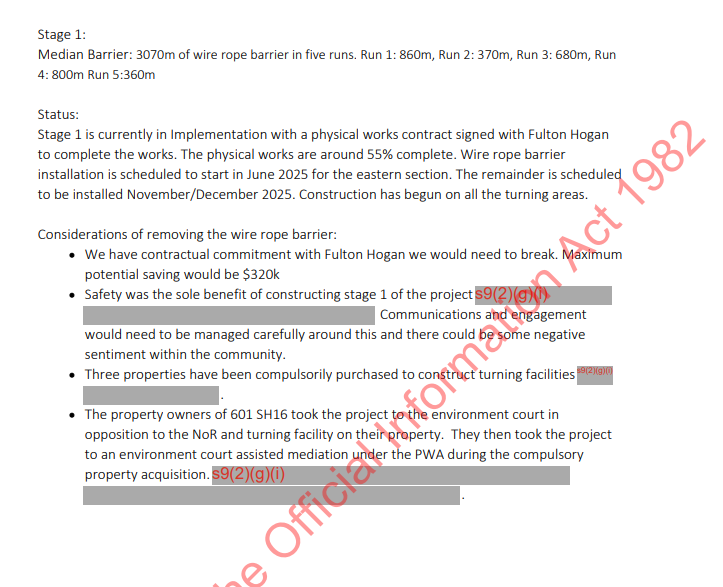 As the email notes, contracts with Fulton Hogan would need to be broken, for a maximum potential “savings” of $320k, a minute amount – while the turning bays are now built, on land acquired at considerable expense. Additionally, ”Safety was the sole benefit of constructing stage 1 of the project‘ and the median barriers had been a key part of all communication and consultation with the community.
As the email notes, contracts with Fulton Hogan would need to be broken, for a maximum potential “savings” of $320k, a minute amount – while the turning bays are now built, on land acquired at considerable expense. Additionally, ”Safety was the sole benefit of constructing stage 1 of the project‘ and the median barriers had been a key part of all communication and consultation with the community.
So not only did this decision by senior management break contractual agreements, it also broke promises the transport agency had made to the community, and defended in court, twice.
With all of these factors screaming this was a terrible idea, why would the NZTA Transport Services Group Leadership Team direct the project team to remove the median barriers?
Ministerial meddling – and a failure of statutory independence
This email from senior management in NZTA justifying the decision was sent out in March 2025. [Note: WRB = wire rope barriers]
- Both the CEAG report and the Environment Court battle said the median barriers were essential to the project’s goal of increasing safety.
- There was no uproar from the community around the barriers, and no media coverage.
- NZTA fought the need for the barriers, and the turning bay, in court. Twice.
And factor in how changing the project at this late stage requires breaking contracts and promises, at a cost to both budget and reputation.
And still the General Manager from Transport Services directed the project team to remove the barriers. Why?
In one of the OIA request replies, NZTA points to “community views” on the one hand, and the new GPS as a factor, with “greater weighting” given to “community and efficiency concerns” on the other:
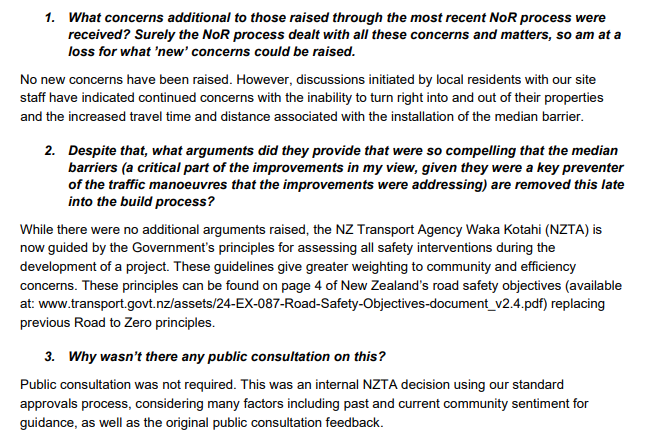 This is also noted in NZTA’s communications and engagement plan for telling the public about the safety downgrade:
This is also noted in NZTA’s communications and engagement plan for telling the public about the safety downgrade:
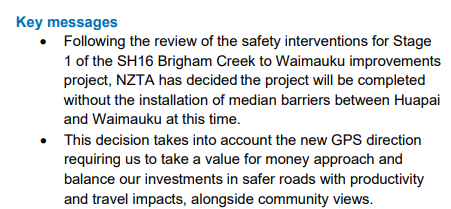 The thing is, Stage 1 of the SH16 Brigham Creek to Waimauku project was already funded, contracted, and halfway through construction. Simeon Brown’s GPS should have had no influence; there was no reason for NZTA to relitigate the project under its guidelines.
The thing is, Stage 1 of the SH16 Brigham Creek to Waimauku project was already funded, contracted, and halfway through construction. Simeon Brown’s GPS should have had no influence; there was no reason for NZTA to relitigate the project under its guidelines.
This is different from the kerfuffle around the Warkworth Hill Street improvements where the project’s funding hadn’t yet been confirmed – so it did have to take direction from the 2024 GPS even if it meant the decision was based on flawed policy.
But the point is that NZTA, under The Land Transport Act 1998, is statutorily independent which is outlined as:
As 3b points out, “the Minister may not give directions to the Agency in relation to performing that function.“. In fact, as Part 3 of the law points out – the GPS is specifically not a direction and also states “To avoid doubt, the GPS on land transport may not impose an obligation on the Agency to approve or decline funding for a particular activity or any combination of activities under section 20.”
And yet as we’ve seen, the former Minister of Transport, Simeon Brown, seemingly gave highly specific direction on NZTA’s independent functions. For example, his GPS mandates that all RoNs be built as four-lane expressways no matter the local conditions and no matter the budget; and specifically bans splitting ‘activities class’ funding between modes which means you cannot fund something like footpaths, from the road activity class, (see also other hands-on-the-wheel policy documents like the 2024 Speed Rule, which explicitly bans the very normal and industry-standard 30km/h as a speed-setting option in urban areas).
Are there a myriad examples of ministerial meddling are playing out as we speak?
Consider projects like the Warkworth Hill Street improvements: why was the Minister calling out specific parts of the project in the media, with blatant disregard for the fact the community had spend years co-designing the project? Is it possible that NZTA chose not to fund the project, due to the Minister essentially banning funding for multi-modal designs?
Or what about The Strand Optimisation Project, the intent of which was to improve safety on a heavy traffic corridor through a well-populated part of the city where lots of people walk and cycle? Having been following this project, I’ve watched as NZTA split the footpaths and crossings into a second stage, meaning extra construction time and presumably higher cost, and redesigned the project to remove specific elements like raised crossings. Again, why? Was it due to a Minister directing its functions?
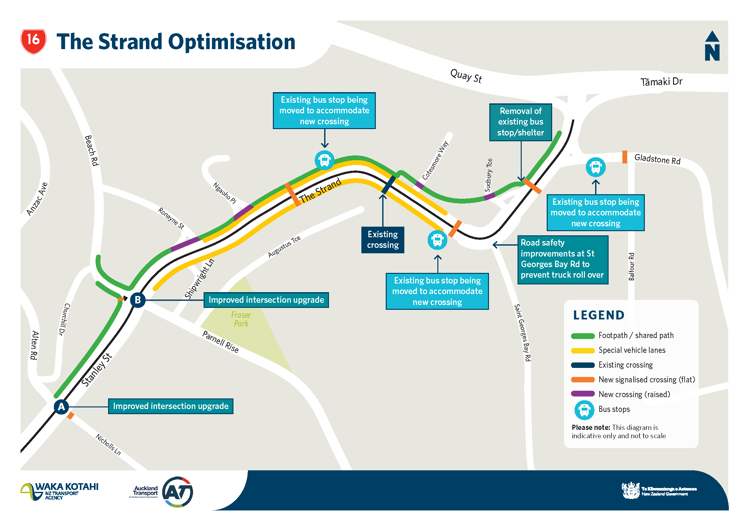
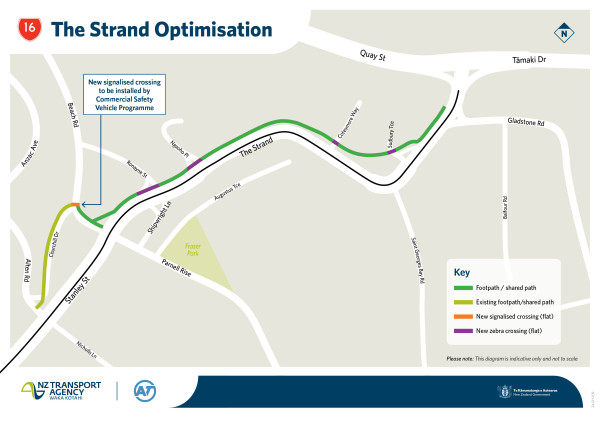
How many other projects have been casually gutted like this, across the country? Hint: it’s probably a lot, and in the process this has destroyed a pipeline of local projects in the 2024 National Land Transport Plan (was this even lawful?). The watering down of so many projects, and the evaporation of promises in the NLTP, seem to show a pattern of NZTA bowing down to the illogical directions of the prior Minister.
But what’s striking about the SH16 Brigham Creek to Waimauku project: not only was it funded, contracted, and under construction, but the final decision to remove the median barriers happened after Simeon Brown had handed the transport reins to Chris Bishop.
So, serious questions need to be asked about NZTA’s so-called ‘statutory independence’, given the way it seems to have bowed down to specific direction from the prior Minister of Transport.
And serious questions need to be raised about the actions of NZTA’s senior leadership on the SH16 Brigham Creek to Waimauku project, given their late-stage redesign of a project already under construction, based seemingly on a Minister’s whim – whether specifically given or pre-emptively guessed at.
What can we do about this?
This news is still filtering through to the community, but we know there’s a significant amount of local upset already.
There may not be a “media outcry” yet, but that’s because when people support a project and believe it’s proceeding as planned (in good faith, having been repeatedly reassured by officials), they won’t speak up – until suddenly it becomes clear the plan has been changed without notice. Then they get angry.
Can this decision be reversed? Well, the project is still under construction – and as one of the OIA responses states “The new detailed design has not been finalised yet. We expect this to be completed by the end of July 2025“. So there’s certainly room for hope.
And at the very least, we deserve accountability for this bizarre decision-making by the highest levels of our transport agency.
To be clear (and as is increasingly common), the problem isn’t the people working on the project: based on the OIA documents, it seems they neither chose nor wanted to do this. As the CEAG document indicates, direction was given to them from above, by the Transport Services Group Leadership Team. So that’s who needs to be accountable.
How to take action
If you’re a local, or drive through here, or just care about good decision-making in Auckland, we recommend sending in an email.
Make sure to state your opposition to this decision, and support an urgent return to the consulted and funded plan to implement a median barrier in this project. Include your own personal reasons for doing so (ie support making the road safer as you travel through often).
Additionally, you should outline concern about how this decision was made given all internal advice in NZTA was ignored, and ask for a proper review into senior leadership’s actions – particularly around the implications of Ministerial influence and direction.
Given the serious concerns about this process, we recommend addressing your email to the following people:
- Project Team: SH16SafetyImprove@nzta.govt.nz
- NZTA Chair Simon Bridges: simon.bridges@nzta.govt.nz
- NZTA Chief Executive’s office: ceoffice@nzta.govt.nz
CC in:
- Auckland Councillor for the Rodney Ward Greg Sayers: greg.sayers@aucklandcouncil.govt.nz
- Rodney Local Board (and any specific local board members you like): rodneylocalboard@aucklandcouncil.govt.nz
- Kaipara ki Mahurangi MP Chris Penk: Chris.Penk@parliament.govt.nz
If NZTA doesn’t look to address this, you can then make a complaint to the Ombudsman.
Remember, always be polite, but do be firm. We do not have to accept last-minute backroom changes that compromise safety and destroy public trust. And, as we have seen with other examples, raising our voices can ensure that what was originally promised will be delivered.
This post, like all our work, is brought to you by the Greater Auckland crew and made possible by generous donations from our readers and fans. If you’d like to support our work, you can join our circle of supporters here, or support us on Substack!
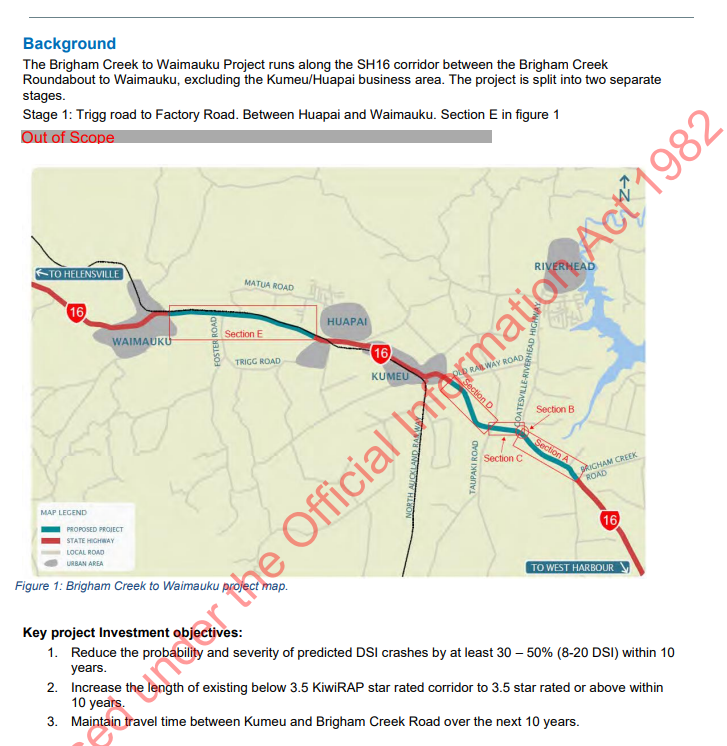
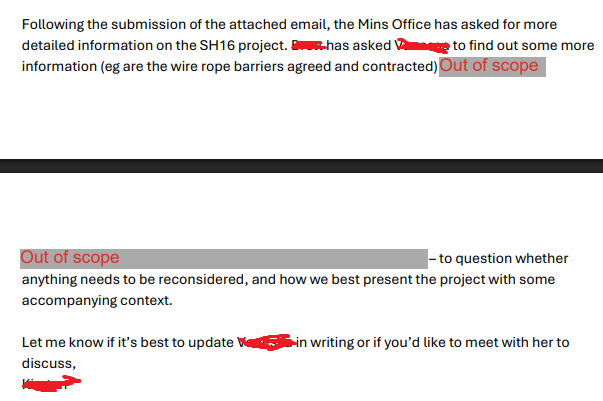


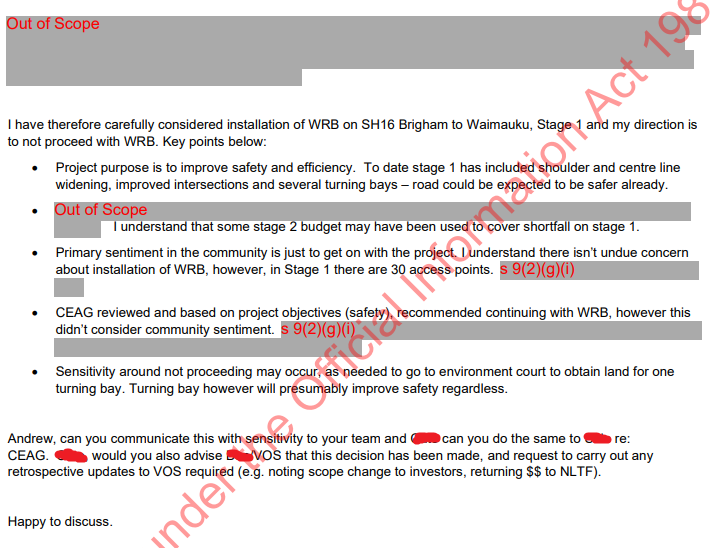


 Processing...
Processing...
Excowork. Carry on that man.
Biking from the NW bikeway and onto the Tamaki Drive bikeway is a popular route. They are the 2 most popular bikeways in Auckland. But it is always risky riding along the Strand connection.
In London, cycling is experiencing a significant surge in popularity. Here in NZ emissions are rising, the battle against bikeways continues and cycling numbers struggle.
I don’t commute through here, but this is absolutely bonkers, and thoroughly deserves the media to drag Simeon through the wringer.
Serious stuff. Terrible government and terrible agency.
It seems to me that the Board should make (and be responsible for) any decision with such legal implications, not the Transport Services Group Leadership Team. Choosing to follow direction that the minister was not within the law to give, and that contradicts statements made by NZTA in court would not usually be something a management team would feel empowered to do.
A quick word search of the last few Board meeting minutes shows nothing. Perhaps it’s there amongst all the redactions?
If the issues wasn’t taken to the Board, is this fact also malpractice by the Transport Services Group Leadership Team?
How many vehicles per day on that stretch of road?
About 36,000, so probably the top canidate in the country for a median barrier.
Do travel this route from time to time to visit family in Helensville . It is very dangerous stretch of road especially Brigams Creek ” hill. More stupidity from whoever is in management in Waka Kotahi. Hard to believe this nonsense a medium barrier is essential. David Wilson
Wow, that is a really bad look. Basically NZTA throwing out all the best practice and just doing whatever they are told by the minister. Very little conviction or principles if they go from defending it in court, to throwing it out over night because one man wanted it gone.
On the other hand Auckland has AT which is really slow to do anything council wants and is now going to be gutted and handed over to the Mayor to play around with.
Seems to me that Simeon Brown has overstepped his mandate and it is time that he is removed from office. The man is clearly not suitable to be a Minister of the Crown, and his employment in this capacity should be terminated forthwith.
His role as transport minister has ceased…. He’s moved on to be the health minister!
so the same BS is and will happen there .God help NZ .
Auckland would be better without NZTA (and Simeon)
The Harbour Bridge would be multimodal by now, and our energy wouldn’t be wasted by ministerial meddling with removal of median barriers on high speed high volume transport corridors.
Thanks Conner (again). Keeping doing what you are doing, future Auckland will be better for it.
Thanks Simeon (not). Reduced speeds on substandard new roading, massive delays as the serious crash unit do their work, increased workload for privatised health services is not what is wanted.
Nasty little weasel, sooner he’s removed from parliament the better.
Road – On the NZTA AADT. North of Huapai was over 15K vehicles a day. Kumeu (North of Access Road) was approaching 23K vehicles per day. Short termism would be to squeeze in three lanes SH 16, Kumeu to Brigham Creek Road and use a moveable barrier (like the Harbour Bridge) for 2/1 with am / pm lane change.
Rail – ‘North South Junction’ the section of single track North of Pukekura Bay shows it is still possible to operate passenger trains through a single track section with tunnels similar to the Waitakere Rail Tunnel section. CAF is doing battery passenger trains.(e.g VRR & NWL – Germany) Widen the rail at Swanson & Huapai/ Kumeu, Waitakere is already wide, and BEMUs could do peak hours, service north of Swanson.
Just wondering, is anyone aware of the reasons behind quietly shelving the Stage 2 of these works?
The works are called Brigham Creek to Waimauku improvements but the reality is that they are now only Huapai to Waimauku. Apparently the Brigham Creek to Kumeu works got shelved last year.
I believe they are back, at least per the projects website (seems to have adjusted the design slightly):
https://nzta.govt.nz/projects/sh16-brigham-creek-and-waimauku#:~:text=Creek%20to%20Kume%C5%AB-,The%20NZTA,-Board%20has%20approved
Given the traffic and speed, why isn’t a concrete barrier being installed?
Is there any reason why they want to remove the barrier? To allow people right turns?
For the speed limits, they at least give a reason even though that’s bogus.
Best guess with Simeon is it’s religious. No need to make people safe or to plan a better world with the End Times nigh. And until then, he seems to have an itch to remake the world in his image: monomodal, inaccessible, toxic, and unpleasant.
It’s quite shocking to see how quick the ‘industry’ has pivoted to removing anything walking/cycling/safety related in projects.
My anecdotal evidence is many local govt discussions with transport engineers that they now can’t do raised tables, or we can’t do certain pedestrian improvements because of the GPS. Not withstanding that solely funded local projects require no consideration of the GPS.
The problem with these sorts of sections in NZ legislation is they assume ministers and public servants will comply with them. This only works if you have politicians who are too embarrassed to breach constitutional norms.
In the post Trump age is no longer the case – witness the routine breaches of the Official Information Act to delay release of information on political grounds. We therefore need to consider adding penalty provisions to these sections of law. Simeon would be much more careful with broadcasting his opinions if he was facing Contempt of Parliament charges.
It’s downright disgraceful finding out how much more damage Simeon Brown had done to our transport planning in just 15 months of being the minister. At least, the good thing is that he is no longer the minister.
Yeah, at least his new portfolio is not that important, after all it is only … *check notes* … the health system.
As a local who grew up in Waimauku but now lives in town, but still drives out most weekends to help with the family farm, I have watched the evolution and development of the area with growing despair. It seems like there is a disease that is unable to be cured causing the most destructive, inefficient, expensive, dangerous and environmentally disastrous way possible. Sprawling greenfields suburbs installed without any improvement to transport. The current works are not even going to catch up with the existing need. They want to build a full motorway with a giant interchange most of the way to Waimauku, destroying great land (e.g. Kumeu River vineyards) and attempting to turn everything into more unsustainable sprawling suburb. Kumeu and Huapai are becoming the worst of USA style stroad stripmall fast food desolation. Westgate is a hell-hole of cars, almost impossible to practically walk from one shop to another.
There should be an absolute ban on any more development until we can get rail working out there. Yep that will be difficult and expensive, I don’t care. We are completely killing the land and creating a financially and environmentally unsustainable dead zone out there if we keep going this way.
Having grown up there and going to Waimauku primary – which boarders SH16 – I know of many people who have bad accidents (including my own family) and deaths of acquaintances. The death cult current government have just re-increased the speed limit past the school. It immediatly goes from 70 back to 60 for the roadwork zone. The roadworks have actually been a pleasure for the last year as it just feels safe cruising from Huapai to Waimauku at 60kph – usually with a queue of jacked up utes behind. I would be happy to lose the median barrier if we could make the speed limit 60 permanently! But obviously that won’t happen so I’ll be emailing demanding the approved and funded plan is adhered to.
This insane car brain development mentality has to end. It’s killing our city and greater region, making people poor, injured and dead. The winners are just the short term developers, land bankers and multi-national construction companies who have no interest in making a better place and only care about next quarter profit.
Apologies – don’t normally rant like that but this obviously hits close to home.
Very understandable that you have so many concerns about development in this area. Government doesn’t seem to grasp that pouring more homes into a productive but flood-prone river valley might have some problems.
Rapid transit and highway corridors south and west of Huapai have been protected by designations, but there is no infrastructure plan to fund those.
Huge housing at Waiuku is only going to add to that unfunded conundrum. Cheapskating on state highway safety is no help.
Has anyone got hold of the Safe System Audits for the project?
Have there even been any done AFTER the change?
There will have to be, but it is worth getting the earlier one to show what was assumed in the scoring. Then they should compare with and without in the next one. For the Tauranga expressways we audited each major change as it occurred so there were no big surprises at the next stage.